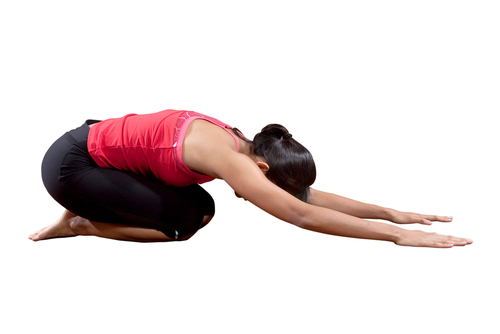Prenatal/Restorative Yoga - Child’s Pose (Garbhasana)
Yoga
Obie Editorial Team
Child’s pose is a great hip opener and spine lengthener. It can be very relaxing and grounding. It is frequently used throughout both gentle and vigorous yoga classes as a way to rest between postures. It is appropriate for any stage of pregnancy with a few modifications.
Directions
Come into the posture by kneeling on both knees at a slightly wide but comfortable distance apart from one another. This distance should be wider than hips width (which can be found approximately by placing two fists between the knees). No need to obsess about the distance, you can always adjust once in the pose to whatever feels comfortable. Then sit on your heels (which should be facing up), and lean forward slowly with your body, walking your arms out long in front of you. Make sure you are breathing as you come into the pose and are not holding your breath, especially if you are feeling any sensation or even pain at this point.
Most people feel a stretch in their hips, lower back and even shoulders and arms during child’s pose. The sensation of stretching should feel gentle and relaxing, not straining in any way. For increased support during this pose and to ensure that you are not using any muscle strength whatsoever, place a pillow (or two) or a thick folded up towel or blanket between your legs and under your torso. Resting on this prop may decrease the intensity and will also allow you to fully relax into the pose. This is what makes the pose restorative: turning off all muscle strength so that the parasympathetic nervous system can turn on.
Stay in this position for up to five minutes (or even longer if you are really loving it) and feel free to come out of it at any time.
- Breath: Don’t worry about controlling your breath, just breathe naturally and freely. If you are having any trouble breathing, try taking a few deep inhalations and exhalations to see how that feels. Maybe once you get in a few deep breaths it will be easier to relax and breathe freely. If you find it helpful to breathe deeply, continue for as long as you need. Some practitioners find a mantra is helpful to increase relaxation. If you are pregnant (or trying to conceive) you might try repeating this mantra in your head with each breath: inhaling I create space for my baby, exhaling I relax.
- Modifications: If you listen to your body, by this point it will probably be telling you if the pose feels right or needs to be adjusted in any way. For example, some people feel soreness/pain in their knees or on the tops of their feet in this pose. In order to alleviate this, try placing a blanket or towel (or extra mat) under your knees and under the tops of your feet for extra cushioning. You might also try rolling up a blanket/towel and placing it behind your knees (between your buttocks and calves) for even more support.
Another thing you may notice, depending on the trimester and size of your belly, is whether or not your knees are wide enough to feel comfortable and spacious in the pose. Feel free to widen your knees as much as possible to increase the space for your growing belly.
- Release: In order to release the pose, slowly walk you arms under you, allowing them to push your torso back up to a seated position. Let your head be the last thing to come up. Try to avoid using any neck strength or strain to lift you up, let your arms do the work. This will help you stay in a relaxed state. Sit in whatever position feels comfortable for a few breaths and observe any changes in your body and mind. When you are ready, move on to the next pose.









